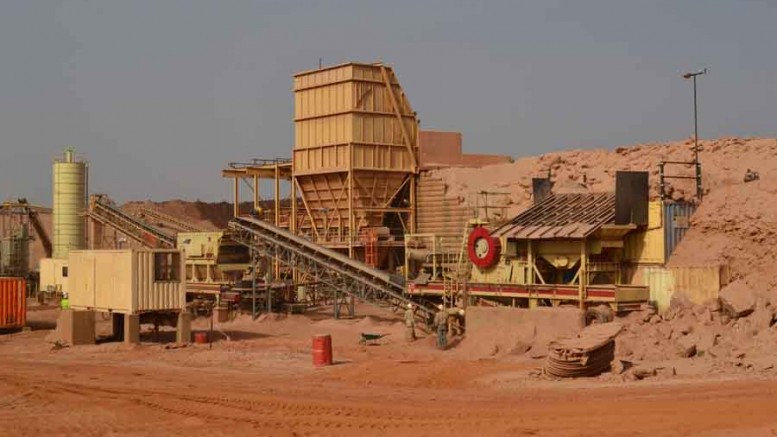West Africa-focused gold producer Amara Mining (AMZ-T, AMA-L), formerly Cluff Gold, is hoping get a little more life out of its 78%-owned Kalsaka gold operation in Burkina Fasom, 150 km northwest of the capital Ouagadougou.
On Oct. 16, the company released a preliminary economic assessment (PEA) on its Sega satellite gold deposit 20 km north of the Kalsaka mine. The PEA confirms the “potential viability” of trucking oxide and transitional material from Sega to the company’s heap-leach operation for processing.
Amara acquired Sega for US$29.6 million from Canadian explorer Orezone Gold (ORE-T) in February. The 313 sq. km Sega land package offers exploration upside and an indicated resource of 4.9 million tonnes grading 1.69 grams gold per tonne for 450,370 contained oz. gold, including 3.3 million tonnes of oxide material, at 1.67 grams gold for 176,000 contained oz. gold.
Kalsaka holds proven and probable reserves totalling 1.7 million tonnes grading 1.5 grams gold for 82,000 contained oz. gold.
“The Sega PEA is a key step in ensuring that cash flow is maintained at our producing mine,” CEO Peter Spivey comments, noting that Sega’s location near the company’s plant would allow it to extend Kalsaka’s life by nearly two years, with limited capital investment. “We are committed to a strategy of using cash flows to develop our growth assets, providing flexibility as we grow into a mid-tier producer,” he says.
According to Amara’s PEA, Sega’s expansion would carry capital costs totalling US$9.5 million. Over half of that capital is required to install a crushing plant on site, as well as necessary mining capital that includes building a haul road.
Under Sega’s open-pit design, 2.5 million tonnes would be mined at a head grade of 2 grams gold for 162,825 contained oz. The operation would produce 17.3 million tonnes of waste, have a strip ratio of 6.8 to 1, and cash costs of US$2.59 per tonne.
At a US$1,500 per oz. gold price, Sega carries a 48% internal rate of return and US$49.5-million net present value at a 10% discount rate. Cash costs come in at US$821 per oz. before royalties, and Amara expects to generate US$59 million in post-tax cash flow.
Orezone completed metallurgical test work on Sega before the sale was finalized in May. According to results, Sega’s ore is non-refractory, and returned an overall recovery of 87% for oxide material and 70% for transitional material. Amara says the results indicate Sega contains comparable mill feed to its existing resource, and should be able to maintain a 1.6-million-tonne-per-annum throughput rate at Kalsaka’s processing plant.
Amara hopes to start trucking ore from Sega in the first half of 2013. At presstime the company planned to submit its permit applications before November, and has already received “verbal authorization” from the government to begin infrastructure work in advance of its final mining licence. Amara plans on starting construction on the haul road, on-site crushing facility and upgraded power plant by year-end.
Amara also released results from 19,000 metres of reverse-circulation drilling at Sega, with significant intercepts reported from the Touli, Sampella and Bangassila prospects.
At Touli the company cut 26 metres grading 3.05 grams gold from 8 metres depth in hole SRB0232, and 18 metres averaging 3.49 grams gold from 18 metres in hole SRB0290. Results at Sampella were highlighted by 5 metres grading 3.48 grams gold in hole SRC0052, while Bangassila returned 4 metres carrying 2.07 grams gold in hole SRC0083.
Exploration is also ongoing at Kalsaka, with a resource update expected by year-end focusing on areas east of the K-zone pits along the K-zone structure.
“The exploration results received from the Kalsaka-Sega complex have confirmed that there is significant upside resource potential,” Spivey comments.
Amara is planning to use cash flow from its Burkina Faso operations as fuel for a development pipeline that includes its flagship Baomahun gold project in Sierra Leone, which holds 25.6 indicated tonnes grading 2.5 grams gold for 2.07 million contained oz. gold. The company received its environmental permits for the project in April, and is close to completing a feasibility study on a 2-million-tonne-per-annum, carbon-in-leach operation producing an average 130,000 oz. gold annually over an eight-year mine life.
The company is on track to produce between 60,000 oz. and 70,000 oz. gold this year.
Amara has 161 million shares outstanding and a $195-million press-time market capitalization at a $1.21 share price.
It held US$28.8 million in cash and equivalents at the end of June.


Be the first to comment on "Sega looking good to Amara in Burkina"